Did you know that you can estimate the familial relationship between two people based on the amount of shared DNA? All you need are a few DNA tests, some test-takers, and a bit of know-how. This guide will teach you how to analyze shared DNA, determine the possible relationships, and predict the actual relationship using genetic genealogy. But first, we need to talk about how DNA is inherited.
DNA Inheritance
For simplicity, I’ve boiled this complicated topic down to three main points: chromosomal inheritance, recombination, and centimorgans.
Chromosomal Inheritance
A child receives 50% of their DNA from their father and 50% from their mother. Therefore, it is reasonable to assume each pair of full siblings shares around 50% of their DNA, right? Likewise, one may think that half-siblings share about 25% of their DNA, right? Unfortunately, DNA inheritance is a bit more complicated than that. DNA undergoes an entire process before an egg and a sperm ever meet.
We have 23 pairs of chromosomes, a total of 46. A child will get one copy of each chromosome from each parent. The first 22 pairs of chromosomes are autosomes. The 23rd pair is the sex chromosome. The sex chromosomes, X and Y, are unique in that they specify gender. Females will have two X chromosomes, and males will have one X and one Y chromosome.
As mentioned, the mother’s 23 chromosomes are not the same 23 chromosomes that all of her children will inherit. There is a biological process that occurs called meiosis when the egg is being produced. This process randomly gives one chromosome of the pair for each of the 23 pairs of chromosomes. It is literally a 50/50 chance on which chromosome of each pair the egg will get. A similar process occurs with males. In males, however, the sex chromosome that’s inherited can be X or Y. This is why it’s a 50/50 chance a person will be born male or female. Note that the old adage of a man telling a woman, “will you give me a son?” is a complete misnomer. It is actually the FATHER that gives the X or Y chromosome!
How does all of this play into siblings not having precisely 50% of the same DNA? Think of a person as the product of their four grandparents instead of just their parents. That is because their parents actually carry their grandparents’ chromosomes minus the recombination (this is elaborated on further below). Now using this framework, consider an example of 2 siblings:
Sibling A happens to be born with many chromosomes from their maternal grandmother and not from their maternal grandfather. They also happen to inherit a large representation of their paternal grandmother’s chromosomes and not many from their paternal grandfather. Therefore, most of their chromosomes are from their two grandmothers.
Sibling B has the exact same parents. However, in this example, sibling B inherits mostly chromosomes from their two grandfathers.
With the example above, the two full siblings share less than 50% of the same DNA. All because one happened to receive more chromosomes from one side of the family. And the other sibling received more chromosomes from another side of the family. This is known as the Chromosomal Theory of Inheritance.1 Next, we discuss DNA recombination, which is another way relatives can have differing amounts of shared DNA. Consider this example when dealing with two full-siblings who receive two different ethnicity reports:
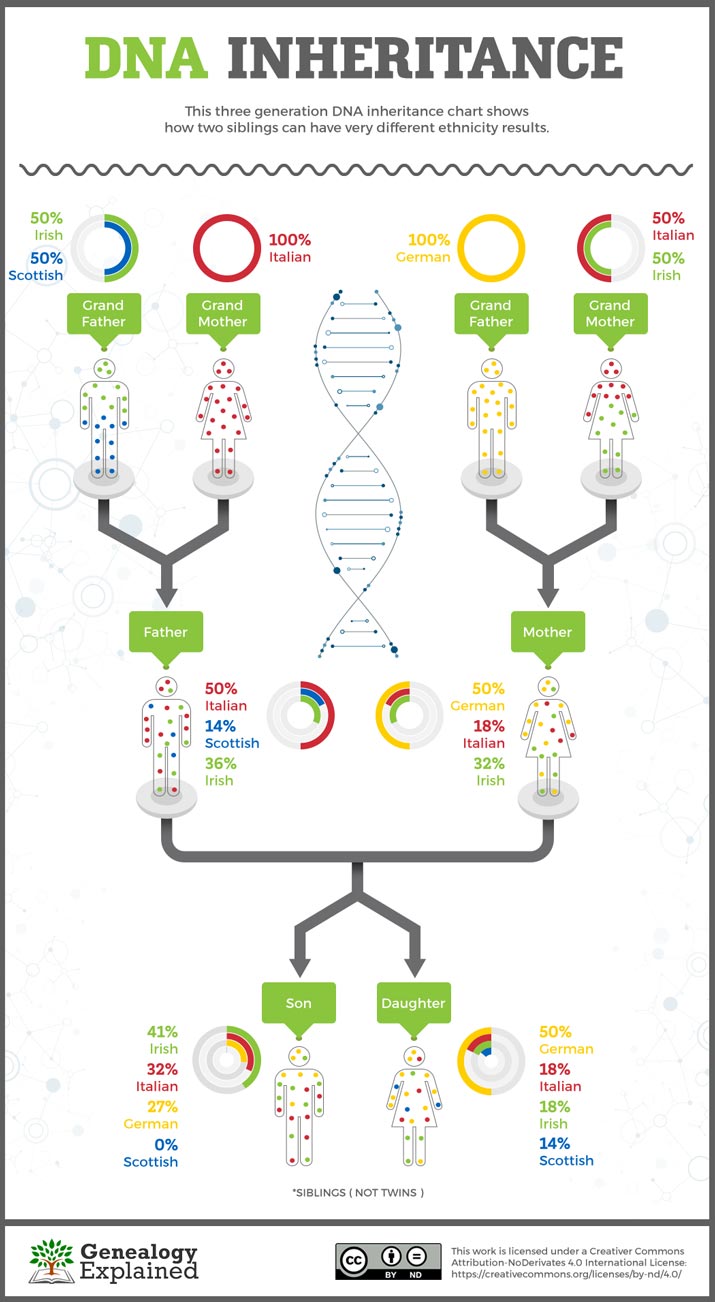
Genetic Recombination
Before the chromosomes from mother and father even meet, there is actually a mixing of the genes. This process is known as recombination and works something like this: a mother has chromosomes both from grandma and grandpa. These chromosomes are in pairs, as described above, numbered 1-22, and then an X or Y as the 23rd chromosome. Each pair of chromosomes lines up and then can touch and exchange genes. There are different likelihoods that specific genes and parts of each chromosome will meet and exchange.
What is the result? New chromosomes are made, different than that of grandma or grandpa! These new chromosomes contain genes of both grandma and grandpa. This is one of the reasons that no two people are ever identical besides identical twins.
Some genes are more likely to be inherited together, usually because of their proximity on a chromosome. This is known as genetic linkage. This randomization of chromosomes, along with recombination and genetic linkage, create statistical probabilities of how much DNA will be shared between relatives.
Centimorgans
A centimorgan (cM) is a unit of measurement commonly used to describe the amount of shared DNA between two people that is identical by descent (IBD). Each centimorgan corresponds to about 1 million base pairs of DNA. The statistical analysis behind a centimorgan considers how likely it is that cross-over and recombination occurred during meiosis (the reproductive even). For example, an individual would share about 3487 cM with a child and 3485 cM with a parent. That’s because a child or a parent will share around 50% of the same DNA regardless of recombination or what chromosomes are passed on. On the other hand, siblings, on average, have about 2613 cM or a range of 1613-3488 cM. This is due again to recombination and the random distribution of chromosomes one inherits. More on shared centimorgans.
Relationships
Now that we understand centimorgans, chromosomal inheritance, and DNA recombination, let’s explore some common relationships.
How much DNA do half-siblings share?
Half-siblings share 1,759 cM of DNA on average. That’s about 25% of your DNA. The range is between 1,160 and 2,436 cM according to the Shared Centimorgan Project. Contrast those numbers with full-siblings who share 2,613 on average, ranging from 1,613-3,488 cM.
- Half-siblings: 1,160 – 2,436 cM
- Full-siblings: 1,613 – 3,488 cM
Notice that these ranges of centimorgans overlap pretty significantly:

So, if two full-siblings happened to have a lower amount of shared DNA because of chromosomal inheritance and DNA recombination, a direct-to-consumer DNA test may erroneously say that someone is a half-sibling despite them actually being full siblings.
To correct this, companies like Ancestry and 23andMe will detect the fully identical regions (FIR) shared by full siblings. Fully identical regions are unique and only found in full-siblings because there needs to be a matching segment at the same location on both copies of the same chromosome. That can only happen if two people got their DNA from the same two parents. The image below shows what fully identical segments will look like for full-siblings.
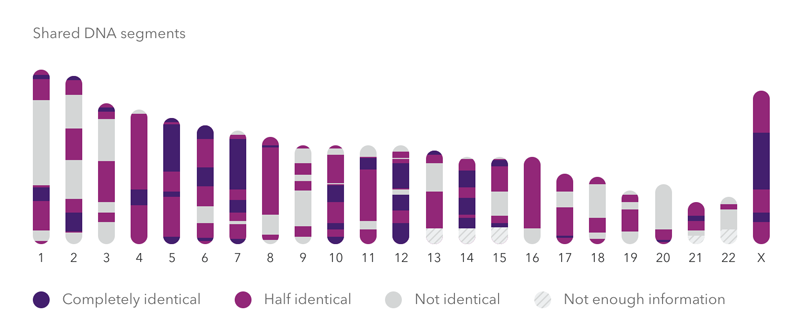
Half-siblings only share half-identical regions. The segments of shared DNA are found only on one copy of the particular chromosome – either the maternal or paternal. In fact, every other familial relationship is based on half-identical regions. The only exception being double cousins where you’re related to someone on both your maternal and paternal lines.
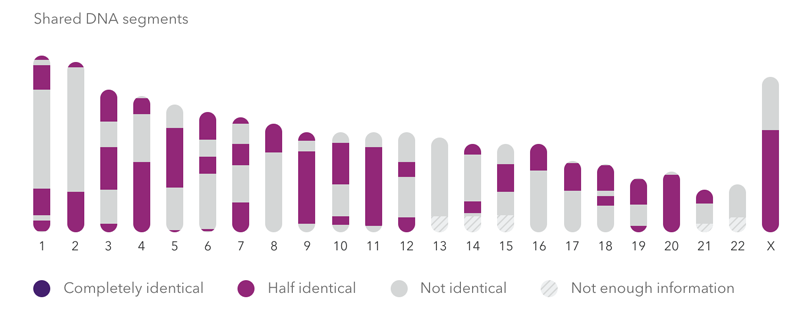
You can see the end result of this additional layer of FIR analysis in this graph from Ancestry:
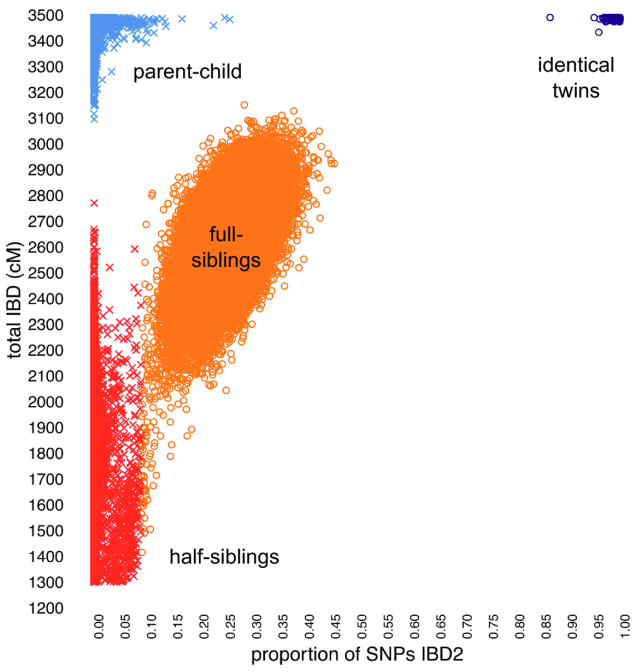
It can be worrying if you and a full-sibling test with the same company and the results say you’re half-siblings. Let’s look at half-siblings on Ancestry:
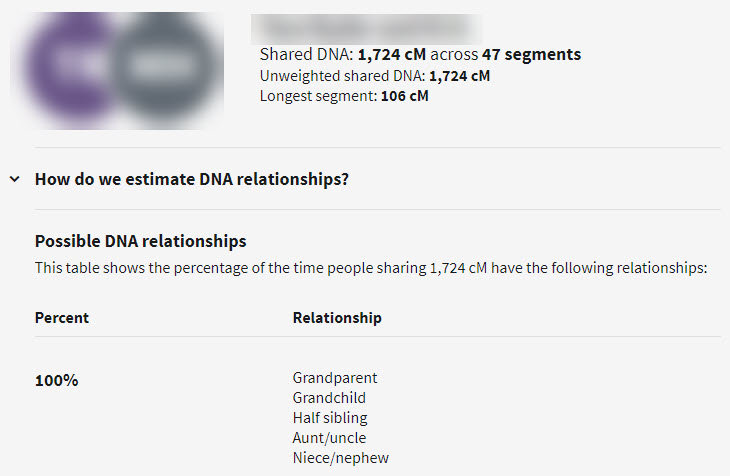
In this case, the predicted relationship on the main match list is half-sibling. But when you click in for more detail, Ancestry also lists other possible relationships based on 1,724 cM. Notice there’s no full-sibling possibility? This amount of DNA is technically in-range to be a full-sibling (albeit an outlier), but Ancestry didn’t detect any FIR so full-sibling is not possible. Learn more about how half-siblings show up on AncestryDNA.
What if you think the DNA test is just wrong? Then what can you do?
The easiest approach is to simply test both parents if they’re living and willing to test. As mentioned before, parent-to-child DNA comparisons are around 3485 cM and there is virtually zero overlap with any other relationship. Suppose the results show that the two parents both share a centimorgan range consistent with being biological parents. In that case, the siblings are full siblings.
But what about if one or both parents are no longer alive? This is really where you need to rely on fully identical regions. You can also think about Y-DNA and/or mitochondrial testing. These tests are not able to prove a specific relationship, rather they’re meant to disprove a specific relationship. For example, two brothers who share the same father will share a Y-chromosome. If they don’t, then they don’t have the same father. Similarly, any two siblings who share the same mother will share the same mitochondrial DNA. Note that a Y-DNA test will not work between two sisters or a brother/sister since women do not have a Y chromosome.
To better visualize overlapping relationships based on the amount of total shared cM, I created a tool called The Shared cM Project Graph.
What about first cousin vs. half-sibling?
Can a direct-to-consumer DNA test show that my half-sibling is my first cousin? The answer is yes. When the family tree is unclear, and the centimorgans of two people are in the 1300 range, several possibilities could exist: first cousin, half-sibling, great aunt/uncle, niece/nephew, great-niece/nephew, even half niece/nephew, etc. There are many possibilities. Again, there are tests available to help narrow down these possibilities.
Final Thoughts…
DNA inheritance is complicated. It involves chromosomal inheritance and DNA recombination. We measure the similarities between two people with a statistical unit called a centimorgan. These direct-to-consumer tests provide some information for possible relationships. Still, there can be an overlap in the amount of DNA various relatives share. To sort through these possibilities, a family tree or a pedigree is critical. And remember, no test is 100% accurate because of how DNA is inherited and any unknowns in the family tree.
References
PORTIN P. The birth and development of the DNA theory of inheritance: sixty years since the discovery of the structure of DNA. J Genet. 2014;93(1):293-302. doi:10.1007/s12041-014-0337-4
Capecchi MR. Altering the genome by homologous recombination. Science. 1989;244(4910):1288-1292. doi:10.1126/science.2660260
Dawn Teare M, Barrett JH. Genetic linkage studies. The Lancet. 2005;366(9490):1036-1044. doi:10.1016/S0140-6736(05)67382-5
Painter DNA. Shared cM Project 4.0 Tool v4 with relationship probabilities. Accessed November 12, 2020. https://dnapainter.com/tools/sharedcmv4
Bettinger B. Version 4.0! March 2020 Update to the Shared cM Project!. The Genetic Genealogist. Accessed 13 November 2020. CC 4.0 Attribution License. Data only.


I’m confused it say someone could be my aunt or half half sibling, we share nineteen percent DNa1307 percent cm and 33 seg and she couldn’t be my aunt because she come up on my father’s side and her mother and my mother and father around same age problems is both us dont know are father